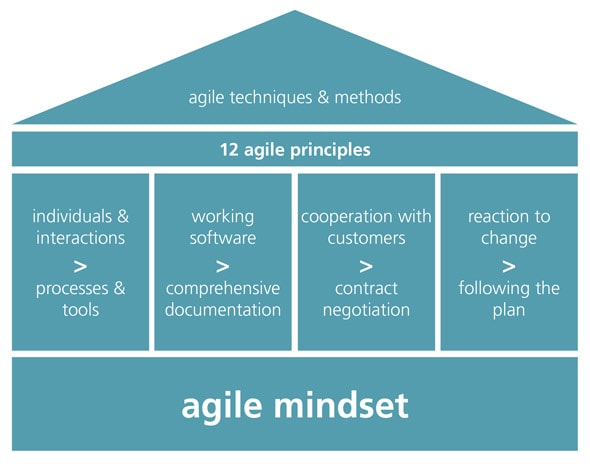Agile Methods
Agile methods refer to the flexible implementation of software projects and by this time has become an indispensable part of the daily routine of many IT organizations. Agile methods were originally developed to manage small teams who needed to develop a product quickly and across a number of disciplines.
Today, agility methods are being used increasingly for large projects and in complex organizations. However, these methods then need to be adapted and expanded accordingly, but in such a way that the original benefit of the approach remains, namely the flexibility to respond to changes quickly. In that context, the approach is then referred to as Agile 2.0.
With Agile 2.0, the agile mindset and agile methods are making their way into large organizations and projects as well. However, being “agile” shouldn’t just be an end in itself. Any organization which wants to develop an agile attitude must also undergo a cultural change. At the same time, agile methods and techniques must also be applied and integrated in a meaningful way.
Agile Mindset & Agile Methods
The term agile refers to a set of widely varying methods and techniques, some of which come from the field of industrial manufacturing and some of which come from the field of software development. In the 1990s these sectors were closely bundled together. The approach’s underlying values and principles were first put on paper at a meeting in Utah in 2001 as the Manifesto for Agile Software Development.
These deliberations centered on flexibility, cooperation and a focus on customer value. The most common agile methods include:
- Scrum
- Unified Process
- Extreme Programming
- FDD
- RAD
- Agile Enterprise
- AMDD
- DSDM
- EVO
Another primary challenge in integrating agile methods and processes within an organization lies in not turning the graphic above upside down – in other words, not starting from the methods themselves, but beginning with the mindset.
Challenge: Being agile
Challenges which new agile methods must meet include:
- Agile development distributed over multiple teams
- Collaboration with non-agile projects and suppliers
- Integration within demand and portfolio management
- Agile teams in distributed locations
- Applying agility in project analysis and planning as well
- Inclusion of agility in estimation procedures
- Taking agility into account for invitations to tender and supplier interfaces
- Integration of agile development in traditional controlling and reporting
- Agility in the development of critical systems
- Integration of agile development in quality management
Our consulting approach with regard to agile methods
We combine flexibility with predictability so that even complex projects can take advantage of agile methods.
Leveraging potential
Any organization which wants to leverage the potential of agile methods must not think in terms of black and white or get caught up in thinking in stereotypes between agility and conventional methods. Instead, the focus should be on integrating and using the full potential of agile methods. In addition, predictability, traceability and quality management must not be left out of the equation.
The fact that all these issues can be bridged is proven by the many projects which have met success in the light of Agility 2.0.
The experts at Spirit in Projects will support you step-by-step in establishing agile processes in your organization or in planning, developing and carrying out agile projects.


